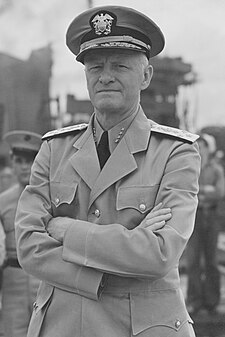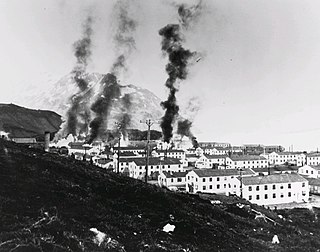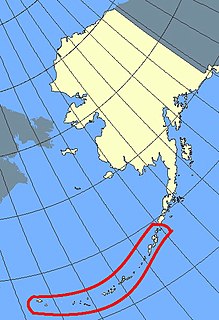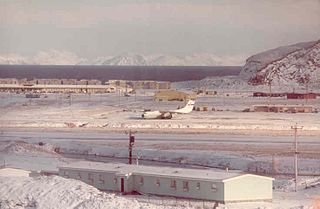
Nachi (那智) was the second vessel completed of the four-member Myōkō class of heavy cruisers of the Imperial Japanese Navy (IJN), which were active in World War II. The other ships of the class were Myōkō, Ashigara, and Haguro. She was named after a mountain in Wakayama Prefecture.
This is a list of aviation-related events from 1943:

The Battle of the Komandorski Islands was a naval battle between American and Imperial Japanese forces which took place on 27 March 1943 in the North Pacific, south of the Soviet Komandorski Islands. The battle was a daylight surface engagement in which air support played no role and in which the inferior American force escaped greater damage after the Japanese chose to withdraw.
This is the order of battle for the World War II Battle of Midway, which took place 4–7 June 1942.

The Battle of the Coral Sea, a major engagement of the Pacific Theatre of World War II, was fought 4–8 May 1942 in the waters east of New Guinea and south of the Bismarck Islands between elements of the Imperial Japanese Navy and Allied naval and air forces from the United States (U.S.) and Australia.

The Aleutian Islands campaign was a military campaign conducted by the United States, Canada, and Japan in the Aleutian Islands, part of the Territory of Alaska, in the American Theater and the Pacific Theater of World War II starting on June 3, 1942. In the only two invasions of the United States during the war of a U.S. incorporated territory, a small Japanese force occupied the islands of Attu and Kiska, where the remoteness of the islands and the challenges of weather and terrain delayed a larger American-Canadian force sent to eject them for nearly a year. Successful Japanese invasions of other U.S. territories, which were unincorporated territories, in the western Pacific shortly after the Attack on Pearl Harbor included Wake Island, Guam, and the Philippines. The islands' strategic value was their ability to control Pacific transportation routes as US General Billy Mitchell stated to the U.S. Congress in 1935, "I believe that in the future, whoever holds Alaska will hold the world. I think it is the most important strategic place in the world."

Boshirō Hosogaya was an admiral in the Imperial Japanese Navy during World War II.

The Eleventh Air Force (11 AF) is a Numbered Air Force of the United States Air Force Pacific Air Forces (PACAF). It is headquartered at Joint Base Elmendorf–Richardson, Alaska.

The first USS Dewey (DD-349) was a Farragut-class destroyer of the United States Navy, launched in 1934 and named for Admiral George Dewey. Dewey served in the Pacific through World War II. After escaping damage during the attack on Pearl Harbor, Dewey screened the aircraft carrier USS Lexington until the carrier was lost in the battle of the Coral Sea; then screened USS Saratoga through the invasion of Guadalcanal and the battle of the Eastern Solomons. Following overhaul in San Francisco, Dewey spent 1943 in Alaskan waters supporting the invasions of Attu and Kiska. Dewey spent 1944 supporting raids in the Marshalls, Carolines, and Marianas, including screening carriers during the battle of the Philippine Sea. After being damaged by Typhoon Cobra during the recapture of the Philippines, Dewey supported the invasion of Iwo Jima and spent the remainder of the war screening replenishment oilers.

USCGC Onondaga (WPG-79), a United States Coast Guard cutter, was built by Defoe Boat Works in Bay City, Michigan, commissioned on 11 September 1934. From her commissioning until 1941, Onondaga was stationed at Astoria, Oregon, where she performed important law enforcement duties and rendered much assistance to ships in distress. Each year she patrolled the annual pelagic seal migration to the Pribilof Islands, and she attempted to prevent out of season halibut fishing.

Abukuma (阿武隈) was the sixth and last of the Nagara class of light cruisers completed for the Imperial Japanese Navy (IJN), and like other vessels of her class, she was intended for use as the flagship of a destroyer flotilla. She was named after the Abukuma River in the Tōhoku region of Japan. She saw action during World War II in the Attack on Pearl Harbor and in the Pacific, before being disabled in the Battle of Surigao Strait in October 1944, then bombed and sunk by the United States Army Air Forces (USAAF) off the coast of the Philippines.

Tama (多摩) was the second of the five Kuma-class light cruisers in the Imperial Japanese Navy, which played an active role in World War II. Tama was named after the Tama River in Kantō region of Japan.

Kiso (木曾) was the fifth and last of the five Kuma-class light cruisers, which served with the Imperial Japanese Navy during World War II. She was named after the Kiso River in central Honshū, Japan.

The Battle of Dutch Harbor took place on June 3–4, 1942, when the Imperial Japanese Navy launched two aircraft carrier raids on the Dutch Harbor Naval Operating Base and U.S. Army Fort Mears at Dutch Harbor on Amaknak Island, during the Aleutian Islands Campaign of World War II. The bombing marked the first aerial attack by an enemy on the continental United States, and was the second time in history that the continental U.S. was bombed by someone working for a foreign power, the first being the accidental bombing of Naco, Arizona in 1929.

The Battle of Attu, which took place on 11–30 May 1943, was a battle fought between forces of the United States, aided by Canadian reconnaissance and fighter-bomber support, and Japan on Attu Island off the coast of the Territory of Alaska as part of the Aleutian Islands Campaign during the American Theater and the Pacific Theater. In contrast with the tropical climate in the Pacific, Attu is the only land battle in which Japanese and American forces fought in snowy conditions.

The Japanese occupation of Kiska took place between 6 June 1942 and 28 July 1943 during the Aleutian Islands Campaign of the American Theater and the Pacific Theater of World War II. The Japanese occupied Kiska and nearby Attu Island in order to protect the northern flank of the Japanese Empire. Along with the Attu landing the next day, it was the first time that the United States was occupied by a foreign power since the War of 1812, and was one of the two invasions of the United States during World War II.
Amchitka Air Force Base is an abandoned Air Force Base located on Amchitka, in the Rat Islands group of the Aleutian Islands in southwest Alaska.

The military history of the Aleutian Islands began almost immediately following the purchase of Alaska from the Russian Empire by the United States in 1867. Prior to the early 20th century, the Aleutian Islands were essentially ignored by the United States Armed Forces, although the islands played a small role in the Bering Sea Arbitration when a number of British and American vessels were stationed at Unalaska to enforce the arbitrators' decision. By the early 20th century, a number of war strategies examined the possibility of conflict breaking out between the Empire of Japan and the United States. While the Aleutian Islands were seen as a potential staging point for invasions by either side, this possibility was dismissed owing to the islands' dismal climate. In 1922, the Washington Naval Treaty was signed, after which the United States Navy began to take an interest in the islands. However, nothing of significance was to materialize until World War II.

Naval Air Facility Adak, was a United States Navy airport located west of Adak, on Adak Island in the U.S. state of Alaska. After its closure in 1997, it was reopened as Adak Airport. The facility was designated a National Historic Landmark for its role in World War II, although most of its elements from that period have been demolished or lie in ruins.

Shiro Kawase was a vice admiral in the Imperial Japanese Navy during World War II. He was a torpedo expert and his extensive experience as a commander of destroyers and destroyer formations made him more knowledgeable about the escort of convoys than most Japanese commanders of his time. He is best known for his command of the 5th Fleet during the latter stages of the Aleutians campaign in the spring and summer of 1943.
















